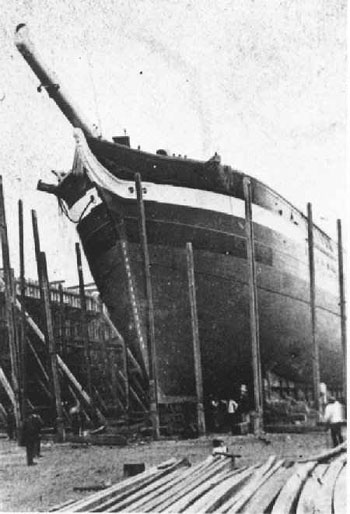 |
AS Whitehaven
grew from a humble fishing hamlet to
a major coal exporting
port in the 17th century it also developed its own shipbuilding
industry.
Although there were earlier shipbuilders in the eighteenth century
such as Thomas Sibson and William Palmer the best known was undoubtedly
Daniel Brocklebank (1742-1801).
He had started building ships at the age of 28 in America and started
building ships there. As the American War of Independence drew to
its close it became clear he would have to take sides between the
Colonials and Britain, so he decided to return home. Taking command
of his last American built ship, the Castor, he sailed her back
to Whitehaven in thirty-two days. In 1788 he established a yard
in Whitehaven where 27 ships were built before his death in 1801.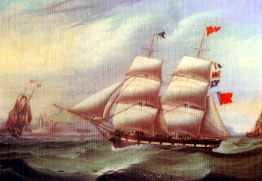
His sons, Thomas and John, started a shipping company which later
transferred its head office to Liverpool. Brocklebanks traded with
Russia, the Far East and South America for a century and a half.
The last official link with Whitehaven was severed in 1865 although
the firm maintained the tradition of buying Whitehaven built ships
until 1885. The shipping line continued to carry freight well into
the 20th century eventually merging with Cunard in 1968. The bicentenary
of Brocklebanks was celebrated in 1970 with a civic reception by
the Whitehaven Town Council. There is a fine collection of oil paintings
of some of Whitehaven's finest tall ships at the Beacon Centre overlooking
the harbour and marina. Each year tall ships visit the port..For
more details visit the Whitehaven Maritime Festival
web pages.
How a Whitehaven ship took elephants to Australia!
Listing of Whitehaven shipping 1811
Details of Whithaven's shipping past can be found in Ships of West
Cumberland costs just £10 and copies are on sale at The Beacon,
The Rum Story, Michael Moon's Bookshop and other outlets throughout
West Cumbria.
British and Irish
Shipyards searchable database.
|
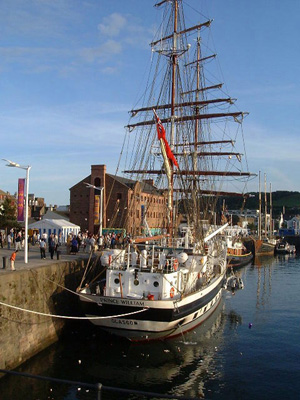 ONE
historical association with the town's shipbuilding
is the Vicar of Bray. This 281 tonne bark was launched at Whitehaven in
1841. She was only 121 feet long and 24 foot wide yet after an early life
as collier. In the 1849 Californian Gold Rush she joined the armada of
ships rushing to San Francisco. She was carrying mercury, and essential
ingredient in the processing of gold. ONE
historical association with the town's shipbuilding
is the Vicar of Bray. This 281 tonne bark was launched at Whitehaven in
1841. She was only 121 feet long and 24 foot wide yet after an early life
as collier. In the 1849 Californian Gold Rush she joined the armada of
ships rushing to San Francisco. She was carrying mercury, and essential
ingredient in the processing of gold.
Here she narrowly escaped the fate of many ships who's crews ran off to
the goldfields. The Vicar of Bray was able to get a skeleton crew and
returned to her sailings. Her skipper, Cpt Charles Duggan was only able
to do this by offering 'gold rush wages' of $80 a month, compared with
the captain's own $50.
In Lloyds register her sailing career ended in 1880 when she became what
she still is today, a hulk in the Falkland Islands. But such is her part
in the Gold Rush that in 1979 the US National Park Service described the
hulk as "one of the most important artifacts of US history.''
SHE was the ship that put the final coffin in Whitehaven’s
once thriving shipbuilding industry. The Alice A Leigh was the biggest
ship built at Whitehaven, and it was when her 3000 tons refused to slip
gracefully into the sea that the problems hit the Whitehaven Shipbuilding
Company.
But the ship, now a tourist attraction as a shipwreck in New Zealand,
has led a Yorkshire woman on a search that is taking her around the world.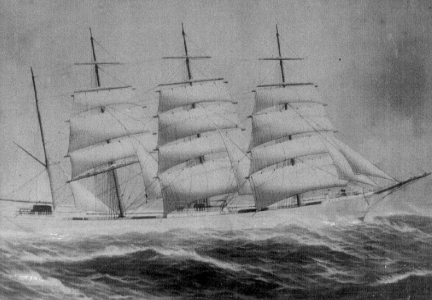
Sally Greer’s great grandfather was the ship’s captain from
1900-1918. And old family photographs led her to uncover a story of high
seas drama. Uncovering the old ship’s logs in the Kew Public Records
and in Whitehaven’s Archives have pieced together the ship’s
story. Recently Sally Greer was in Whitehaven with her father to see the
shipyard site that started the entire saga. Alice A Leigh was a 4 masted
steel barque. She was launched Oct 1889, being built by the Whitehaven
Shipbuilding Company. Recalled Sally: “When she failed to launch
properly it cost the company a further £1400, to free her which
made the company go bust. She cost £26000 to be built. My Great
Grandfather was her Captain from 1900-1917. (Cpt Allan Davison). “He
took his wife Hannah to sea with him and all 6 children were born at various
ports/at sea. (2 died, 1 was actually buried at sea).
The ship had an eventful life nearly being sunk by a German sub in 1916
only to be saved at the last minute as a French destroyer appeared on
the horizon.
On another occasion the Alice A Leigh had to sail through the centre of
a typhoon. This demasted the barque.
“She was sold first in 1917 to New York & Pacific SS Co and then
in 1921 sold again and renamed REWA, converted to an oil barge and in
1930 was sunk at Moturekareka Is (Harauki Gulf) New Zealand as a breakwater.
She is still there to this day. Local boat companies run day trips to
see her. Calling her the 'Pirate ship'.’’
More
details of Alice Leigh on the New Zealand Blog....
Sally who now works in a home for the elderly in Catterick said: “Having
found that the Alice A Leigh’s final resting place was in New Zealand
I decided I should go out to see her. I have heard so many of the
residents at the home say they wish they had done certain things in their
lives, but have left it too late. That made me realise you have to do
what your heart tells you to do!.’’
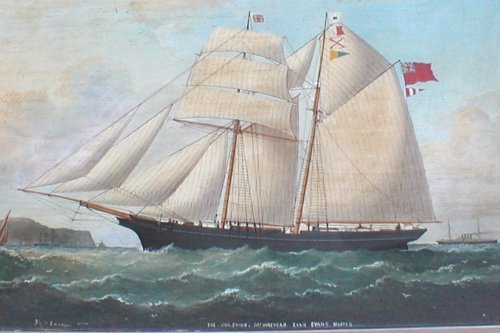
The Clearway
The steam dredger Clearway was a well known character in Whithaven
harbour for some 70 years. She dregded up the silt that tides kept washing
into the harbour mouth. Built in Aberdeen in 1926 she came to Haven a
year later.She was one of the last coal fired steam dredgers in Europe.
In 1992 her triple expansion reciprocating steam engine was mothballed
as the days of phosphate roack cargoes into the port had stopped.
Regrettably despite strenous efforts by the Harbour Master Dave Allan
no preservation society could be found to take on the Clearway. in 1998
a crowd of wellwishers saw the boat off as she was towed to Millom for
scrap. A Norwegian society renovating a 1908 fjord steamer the Oster have
bought the engines and in 2000 summer started sea trials at Bergen. Find
out more on the Clearway, plus picture.
Sea Jade
A Whitehaven built schooner came back to town for a recent visit.
The fascinating storu of the Sea Jaed follows: She was a wooden schooner
that was rescued from the mud at the bottom of Whitehaven harbour for
the princely sum of £5. In August 2001 she was all set to sail off
to the Greek island of Corfu.
The three masted Sea Jade was back in port on crewed by eccentric 66 year
old salty seadog, John Victor Grierson.
John recalls the day 15 years ago that the Harbour Commission's Mr Moffat
asked him to dispose of the sunken wreck. *She had laid in the mud for
four years and as I am a registered wreck recoverer, they asked if I could
dispose of her. I paid £5 for her and got her free from the silt
alongside Whitehaven slipway and off to Barrow where after 15 years slog
I have made her seaworthy once again.** John gained his wreck recovery
licence through his knowledge of using demolition charges. One of his
past contracts was the successful dynamiting of the French wreck, the
Michelle Jane which was causing problems for submarines using the Walney
Channel.
The Sea Jade has two jibs and a mainsail and when John and crewman Hugh
Taylor, from Swarthmoor, Ulverston, sailed her to Whitehaven from the
Isle of Man on Sunday: *Every sail was set and the engine running and
we made over 11 knots in speed.**
On a web site created by Hugh he describes John as *Barrow*s Fred Dibnah*
Among the other projects John described as his *Toys and Projects* include
owning a Centurian tank and reconditioning the huge engine from a Bristol
Hercules aircraft before selling it on to a museum.
Asked about his plan to sail the Sea Jade to Corfu John said: *I am going
to Corfu to live on Sea Jade. I fell in love with the place on a visit.
It may be everyone's ambition, but I am doing it."
Another less inspiring visit by a sailing vessel was the sad tale of the
Ellan Vannin. DREAMS of a sail training schooner for Whitehaven were dashed,when
the old vessel came free from its moorings and sailed out to sea without
a soul on board. As harbourmaster Neil Foskett and HM Coastguards teams
looked on, the twin-masted schooner, Ellan Vannin first had to be fended
off the North Wall of the port before she drifted, under heaving seas,
onto the beach at Whitey Rock, between Whitehaven and Parton.
Looking like the Mary Celeste the old sailing vessel had slowly drifted
to her doom. She had torn herself free of her moorings as she was tied
up and left unattended alongside the Sea Cadets base the TS Bee. Among
those watching the drama unfold were young people from the West Cumbrian
NACRO team who had been intending to start work that very day. The NACRO
team leader, Michael Cullum said he was heartbroken to see the ship founder.
Whitehaven Harbour staff tried desperately to contact the ship's owner,
Tommy Doyle, at the time. Steve Cross, spokesman for HM Coastguard, said:
"The ship apparently broke its moorings at lunchtime. "A team
of coastguards from Whitehaven went out to the ship to make sure no-one
was on board.
"They were intending to try and pull it back, but it was too badly
damaged and could not be saved."
The old schooner, was named after a tragic steamer that sank in Liverpool
Bay in 1909 claiming many lives.
Keeping an eye on the situation, on Thursday, Harbourmaster Mr Foskett
told the Workington lifeboat, which had scrambled, to stand down, as there
was no threat to life or shipping. Mr Foskett said: "Nobody was attending
or manning the vessel as we had asked them to do. On the Monday we advised
it was not a good week to take her out for the planned repairs. But he
(Mr Doyle) said he would take the risk.
"I advised him that if he wished to do that the ship must categorically
be manned during each and every subsequent tide as she
re-floated to attend to lines and fendering. This advice was clearly ignored
as was discovered at the time. On subsequent inspection of the
remaining mooring lines they were found to be in a very poor condition.
We have the remnants of the lines in storage. Conditions at the berth
were fair at the time of failure."
She has now been broken up by the tides and a salvage company will
shortly be clearing her remains from the Irish Sea.
The Wordsworth connection.
A Television film about the exploration by divers of a shipwreck has re-awakened
interest in a Whitehaven sea captain and the tragic death of the brother
to the famous William Wordsworth.
AN ADVERT appeared in the Cumberland Pacquet in April 1789: “Wanted
for a new ship of 1,200 tons, in the service of the Honourable Company
of Merchants of England trading to the East Indies, 30 young and able-bodied
seamen who can produce certificates ... apply Captain Wordsworth, Scotch
Street, Whitehaven.
This was inserted by John Wordsworth, cousin of the poet William, who
was born at Whitehaven in 1754.
Through the influence of George Robinson (a favourite of George III),
one-time MP for Westmorland and agent for the Earl of Lonsdale, John was
made commander of the largest ship in the East India Company fleet, the
Earl of Abergavenny, launched at Harwich in 1789. Needing a large crew,
John drew from a wide area, preferring Cumbrians who he would know and
trust, hence the advert in a local newspaper.
One of the crew on the 18-month maiden voyage to India and China was another
John Wordsworth, born in 1772 at Cockermouth and a younger brother of
the poet, joining the ship on January 3, 1790.
This was an eventful voyage, the Pacquet reporting in July 1791: “Captain
Wordsworth, of this town, had lately the honour of receiving and entertaining
on board his ship, the Earl of Abergavenny, at Canton, the Emperor of
China with a very numerous retinue.”
The East India Company was then extending links with China and the crew
were out to impress.
Documents in Cumbria Record Office in Carlisle show that the vessel was
bringing back to this country cotton, tea and silver as part of a general
cargo.
When the Abergavenny returned on August 19, 1791, Dorothy Wordsworth,
John’s sister, was told: “He is grown a very tall handsome man.”
Whenever possible between voyages, John visited both William and Dorothy
in the Lake District, the last time in 1800.
Sailing at first as a fifth mate, John Wordsworth rose through the ranks
very rapidly, and again with the help of George Robinson, replaced his
cousin as captain of the Abergavenny when John senior resigned on January
2, 1801.
Before Abergavenny’s fifth voyage to Bengal and China, John wrote
to his brother William on January 24, 1805: “In ship’s company
we have 200, and soldiers and passengers 200 more, amounting all together
to 400 so that I shall have sufficient employment on my hands to keep
all these people in order.”
Although he detested writing letters, John sent a last letter to his brother
Christopher on January 31: “We are at Portsmouth and expect to sail
tomorrow, wind and weather permitting.”
Forced close to the coast in poor weather on February 5, the ship struck
the notorious Shambles bank off Portland Bill.
The bank was finally cleared and the crew attempted to sail for Weymouth
Bay, but the hull was so badly damaged that the Abergavenny sank within
sight of land.
Almost 300 perished, along with the captain.
The Pacquet said: “At the moment the ship was going down, Captain
Wordsworth was seen clinging to the ropes. Mr Gilpin, one of the mates,
used every persuasion to induce him to save his life but all in vain –
he did not seem desirous to survive the loss of his ship.”
All blame for the wreck was placed on an incompetent pilot and the captain
absolved.
William Wordsworth wrote from Dove Cottage to Sir George Beaumont on February
11: “This calamitous news we received at 2 o’clock... my poor
sister and wife are in miserable affliction which I do all in my power
to alleviate, but heaven knows I want consolation myself.”
It was not until March 20 that John Wordsworth’s body was found on
the beach near Weymouth and the Gentlemen’s Magazine reported it
was “the next day conveyed in a hearse to the parish church of Wyke-Regis,
followed by a great number of the principal inhabitants of Weymouth and
there interred”.
His sword was retrieved from the wreck and is still in the Wordsworth
family possession.
One of those who survived the disaster was John Routledge of Stapleton
who was on his way back to India as an employee of the East India Company.
Another Cumbrian saved was the third mate and cousin of the captain, Joseph
Wordsworth, who was sent ashore in a boat with other seamen to get help.
Interest in the wreck of the Abergavenny and its valuable cargo has prompted
diving by the Weymouth Underwater Archaeological Group and the ship and
the recovery of artifacts has been the subject of a recent television
programme.
The Whitehavemn ship that carried
the first elephant to Australia...
The Cassiope was a ship built in July 1875 by the Whitehaven
Ship Building Company. In 1883 she carried the first elephant to Australia
!
From the Cumberland Pacquet and Ware's Whitehaven Advertiser,
6th July, 1875, page 2 ;
" SHIPLAUNCH AT WHITEHAVEN - On Saturday last No.18
on the books of the Whitehaven Shipbuilding Company was launched from
the company's premises, the christening ceremony being performed by Mrs.Heap,
daughter of Mr.Joseph Heap, of the firm of Messrs.Heap and Sons, Liverpool,
for whom the vessel has been built. This latest edition to the fast increasing
fleet of iron ships launched at Whitehaven is named the Cassiope. Her
dimensions, &c., are :- Length, 240 feet; moulded breadth, 39 3/4
feet; depth, 24 feet; register tonnage, about 1,550 tons. She is classed
in the double A class at Lloyd's, and is as fine specimen of a sailing
ship - combining strength with carrying capacity - as has been turned
out by the same builders. After leaving the ways the Cassiope was taken
in tow by the Prince of Wales, and berthed alongside the Sugar Tongue,
where she will be 'finished'and then leave for the Mersey. From Liverpool
she will proceed to Melbourne with general cargo, thence to Calcutta with
horses, and home with grain. The Cassiope is sister ship to the Parthenope,
which was built for the same owners, and which left Liverpool about a
month ago."
The Argus newspaper, Monday, 5th March 1883, p4.
Shipping Lists
Cassiope arrived 5 / 3 / 1883 - schooner 1559 tons
Captain - William Wither sailed from Calcutta on 31st Dec. 1882
Passengers -: Cabins - Mrs. Wither, Miss Wither, Mrs. Hodges, Misses Minnie
& Loretta Hodges, and three in steerage.
Jas. Henty & Co. - Agents
Cargo - 1778 chts., 6430 half chts., 141 quarter chts., 111 boxes, 9502
bags rice, 1200 bls. Wool pack, 500 bls. Corn sacks, 303 bls. Gunnies,
332 bls. Potato bags, 269 bags coir yams, 109 bls. Fibre, 325 bls. Jute,
341 bags myrabolan, 125 bls. Cutch, 135 bags linseed, 40 pkts gambier,
35 chts shellac, 10 chts button lace, 68 cases chutney, 25 cases condiments,
19 cases taraminds, 1 case whips, 1 package.
The Argus newspaper, 5th March 1883.
" The iron clipper ship, the Cassiope, has completed
her round voyage hence to Madrid and Calcutta with horses and back with
rice, jute and tea. The tea is the largest shipment which has been brought
here in one bottom. The Cassiope left here in October last and has had
a fair runup. The trip was also successful, only nine of the horses having
been lost.
On the return voyage the Cassiope was less fortunate
in the matter of winds and weather, especially at the commencement and
the close. Captain Withers reports leaving Sand Heads at 10pm on December
31st. The ship was becalmed soon after however and was in sight of the
eastern channel lightship for three days. Light easterly winds and calms
were met with all the way to the equator which was crossed on 13th January
- longitude 93 E. The wind freshed south to south-east until reaching
30 S. For the five degrees of southing the winds were light from the north-east
and variable and then a gale from the south-east was experienced for two
days - Feb. 7th & 8th. There was a continuance of light south-easterly
winds afterwards until Feb. 17th and south-west winds from that date to
Feb. 20th. The winds were subsequently light from the south-east and sou'south-east
until making Cape Otway on Feb. 27th. At 6:00 pm next day just as the
pilot, Mr Draper, was taken on board the wind came away suddenly from
the south-west as if it had been shot through a funnel and it was with
the utmost difficulty that the pilot schooner's boat got back.
The ship at the time was under lower fore and maintopsail
and foretopmast staysail. At 10:00 am she was struck by a terrific gust
which blew the maintopsail and the foretopmast staysails to ribbons. The
ship was almost overborne by the sheer pressure of the winds and lay over
with the rail under water. The ship was blown away through the straits
to within 30 miles of Wilson's Promentory and 39 miles off Curtis Island.
The wind raged with hurricane violence until midnight of Feb. 28th when
it moderated to a fresh gale at south-west, the ship at the time standing
to the southward. By the gale taking off in time the Cassiope was able
to reach the heads on Saturday . On deck the Cassiope has some animals
for The Acclimatisation Society. The ship is in first class order. Captain
Withers claims no notice was taken of his signals off Cape Otway, although
he was close in and kept them flying for a couple of hours. He also signalled
a steamer from Launceston in the straits but no mention was made in her
report of the circumstances."
The Age newspaper, Monday 5th March 1883.
" The ship Cassiope which arrived yesterday morning
from Calcutta, has brought out a number of animals at the insistance of
the Acclimatization Society of Victoria. Amongst these are an elephant
about six years old and between six and seven feet in height, a dozen
small monkeys and nine mongoose out of a total of sixteen which were shipped,
the remainder having died on the way. The survivors seem to be in a perfectly
healthy condition."
The Daily Telegraph newspaper , 5th March 1883
" The ship Cassiope which arrived in the bay yesterday
morning from Calcutta brought a number of animals for the Acclimatisation
Society of Victoria. There were nine species of mongoose out of the sixteen
that were shipped, the remainder having died on the passage. There is
also an elephant on board. The animal is only six years of age but between
six and seven feet in height. It is described by its caretaker as a most
playful creature and perfectly tame . Twelve small monkeys complete her
collection. "
The Cassiope was believed lost with all hands in a cyclone
in March 1884, whilst carrying a rice cargo from Rangoon to London (see
Source 5). She left Rangoon with a cargo of rice on the 23rd February
1884, bound for Falmouth or Queenstown for orders, and after being posted
overdue was listed as "missing" at Lloyds on the 15th October
1884 (see Source 6). Her master was Capt.Henry Lambert (see Source 7).
Possible other sources:
More information from excellent research by Steve Bulman about
Whitehaven shipping.
Britain's nautical history - National
Maritime Museum
Where to stay in the Lakes |
What to do and see in the
Lakes | Lakestay E
mails |
Whitehaven's web site
Copyright © Lakestay All rights reserved.
|
|

